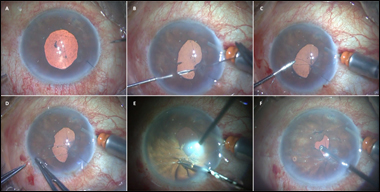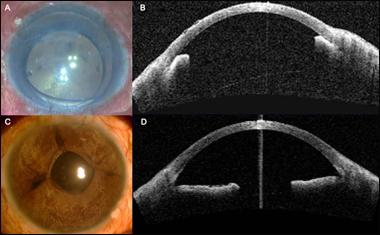Single-pass four-throw pupilloplasty has utility in angle-closure glaucoma
Cases of plateau iris syndrome, Urrets-Zavalia syndrome and secondary angle closure can be treated with this technique.
Single-pass four-throw pupilloplasty, or SFT, is a new variant in the arena of existing techniques and procedures for performing pupilloplasty. Angle-closure glaucoma is characterized by narrowing and crowding of the anterior chamber angle as diagnosed on gonioscopy and anterior segment OCT examination, along with optic nerve changes and elevated IOP.
Laser peripheral iridotomy (LPI) forms the basis of initial therapy in cases of angle-closure glaucoma, but LPI fails to act in cases with plateau iris syndrome (Figure 1), Urrets-Zavalia syndrome and selected cases of secondary angle closure (Figure 2), which lead to the formation of peripheral anterior synechiae (PAS) due to prolonged contact of the peripheral iris tissue into the anterior chamber angle. Argon LPI is often performed to pull the iris from the periphery by causing contraction of the iris tissue induced by the laser shot. Argon LPI needs a laser machine and often needs to be redone due to the wearing-off effect over a period of time. In such cases, surgical pupilloplasty can act by causing the iris tissue to pull away from the periphery and prevent it from falling back into the angle. The mechanical pull induced on the iris due to pupilloplasty causes traction to the recently formed PAS and leads to its breakage, with opening of the angle structures to a greater extent.

Source: Priya Narang, MS, and Amar Agarwal, MS, FRCS, FRCOphth


Surgical procedure
A 360° pupillary stretching at every clock hour is performed with end-opening forceps, which involves pulling the iris tissue toward the center of the visual axis. This helps break the PAS and helps gauge the amount of iris tissue that is available for pupil reconstruction, especially in cases with Urrets-Zavalia syndrome in which there is persistent pupillary dilation with the fall back of the iris tissue into the peripheral angle. In cases with 360° synechiae, often six-point traction is needed, which involves performing the SFT pupilloplasty three times so as to pull the entire tissue from the periphery.
In our short study of five cases, a statistically significant reduction in the degree and area of PAS was noted, which was assessed by gonioscopy and angle digital photography analysis (ImageJ software). The measurement and quantification of the degree of PAS were determined by screening all axes of the angles using anterior segment OCT (Figure 3). Postoperatively, there was a significant deepening of the anterior chamber, and a significant clinical opening of the angle was detected on gonioscopy from the preoperative to postoperative period. There was a considerable decrease in IOP and improvement in visual acuity in all of the cases in the postoperative period. A Goldmann three-mirror lens was used to perform gonioscopy, and a modified Shaffer’s grade was assigned for each quadrant. In a case of Urrets-Zavalia syndrome, cut-through of the iris tissue during passage of the needle was observed due to associated iris atrophic patches. In such cases, extreme care should be taken and the needle should be passed carefully, avoiding all areas of iris thinning to prevent any further chaffing of the iris tissue.
There are certain limitations with this procedure. First, it cannot be performed in phakic eyes and hence needs a cataract extraction to be done simultaneously. Performing cataract surgery in cases with angle-closure glaucoma is a standard treatment adopted by various surgeons. Hence, the issue of lens presence can be overruled, taking into consideration the potential advantages that are offered following a cataract surgery in cases with angle-closure glaucoma. Second, because it is an intraocular procedure, it carries the usual surgical risks and may be associated with induced inflammation in an already inflamed eye.
The advantage of performing SFT is that the pupil has been documented to dilate after instillation of mydriatics, which was quantified on anterior segment OCT analysis. After mydriatic instillation, a clinically significant increase in pupillary size occurred, with higher mydriasis in the vertical axis as compared with the horizontal axis. The induced mydriasis was significant, and it is theorized to aid in fundus visualization and monitoring of glaucoma progression.
- References:
- Kumar DA, et al. J Cataract Refract Surg. 2017;doi:10.1016/j.jcrs.2017.07.027.
- Narang P, et al. Eur J Ophthalmol. 2017;doi:10.5301/ejo.5000922.
- Narang P, et al. Single pass four-throw pupilloplasty (SFT) for angle closure glaucoma. Indian J Ophthalmol. In press.
- For more information:
- Amar Agarwal, MS, FRCS, FRCOphth, is director of Dr. Agarwal’s Eye Hospital and Eye Research Centre. Agarwal is the author of several books published by SLACK Incorporated, publisher of Ocular Surgery News, including Phaco Nightmares: Conquering Cataract Catastrophes, Bimanual Phaco: Mastering the Phakonit/MICS Technique, Dry Eye: A Practical Guide to Ocular Surface Disorders and Stem Cell Surgery and Presbyopia: A Surgical Textbook. He can be reached at 19 Cathedral Road, Chennai 600 086, India; email: dragarwal@vsnl.com; website: www.dragarwal.com.
- Priya Narang, MS, can be reached at Narang Eye Care & Laser Centre, Ahmedabad, India; email: narangpriya19@gmail.com.
Disclosures: Agarwal and Narang report no relevant financial disclosures.









